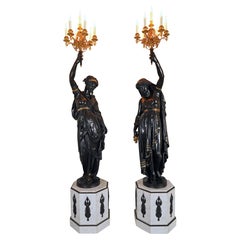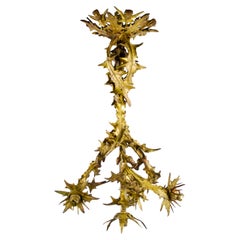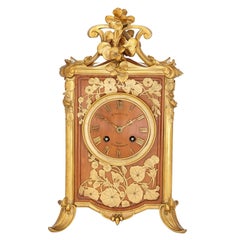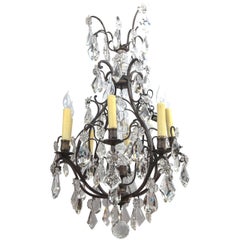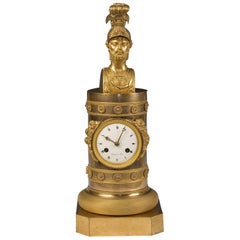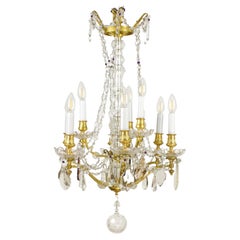E. Colin & Cie Furniture
to
3
3
2
2
1
1
3
3
1
1
1
3
3
3
3
3
1
11,636
3,899
2,412
2,232
Creator: E. Colin & Cie
Pair of torcheres “Night” & “Day” model by Carrier-Belleuse & E.Colin, 19th C
By E. Colin & Cie 1, Albert-Ernest Carrier-Belleuse
Located in PARIS, FR
Total height : 257 cm (101,2 in.) ; Base height : 52 cm (20,5 in.) ; Base width : 48×48 cm (18,9×18,9 in.)
Exceptional pair of female torcheres, made in dark patinated bronze with g...
Category
Late 19th Century French Napoleon III Antique E. Colin & Cie Furniture
Materials
Marble, Bronze
E. Colin & Cie, Patinated Bronze Art Nouveau Thistle Chandelier, France 1900s
By E. Colin & Cie 1
Located in PARIS, FR
Magnificent gold and orange patina bronze Art Nouveau thistle chandelier by the Emile Colin & Cie manufacture, France circa 1882-1898. Stamp of the...
Category
1880s French Art Nouveau Antique E. Colin & Cie Furniture
Materials
Bronze
Art Nouveau Period Gilt Bronze Mounted Wooden Mantel Clock by Colin & Cie
By E. Colin & Cie 1
Located in London, GB
This elegant antique mantel clock is of the Art Nouveau period, and is set within a fine rectangular wooden case embellished with gilt bronze (ormolu) borders and floral decorations.
The clock was made by renowned Parisian maker E. Colin & Cie, and its central circular wooden dial...
Category
Early 20th Century French Art Nouveau E. Colin & Cie Furniture
Materials
Bronze
Related Items
1900s French Bronze Black Framed Crystal Chandelier
Located in Los Angeles, CA
1900s French bronze black framed crystal chandelier. This chandelier has eight lights and has been newly wired.
Category
1930s French Vintage E. Colin & Cie Furniture
Materials
Crystal, Bronze
Empire Gilt Bronze Clock Mantel, circa 1800
Located in Saint-Ouen, FR
An Empire gilt bronze clock mantel, circa 1800
The case surmounted by an Alexander the Great bust.
Dial signed: "Rocquet à Paris” France.
Category
Early 1800s French Antique E. Colin & Cie Furniture
Materials
Bronze
Matching Pair of Figural Patinated Bronze Flame Torcheres after Clodion
By Claude Michel Clodion
Located in Vancouver, British Columbia
A beautifully cast matching pair of patinated bronze figural torcheres in the manner of Clodion modeled as classically draped young girls with garlands of flowers in their hair and h...
Category
Late 19th Century French Napoleon III Antique E. Colin & Cie Furniture
Materials
Bronze
Alabaster Art Nouveau Pendant Light, 1900s
Located in Amsterdam, NL
Stunning and rare Art Nouveau pendant light.
Striking Dutch design from the 1900s.
Original multi-colored alabaster shade with original brass canopy and rope cords.
This wonderful Ar...
Category
Early 1900s Dutch Art Nouveau Antique E. Colin & Cie Furniture
Materials
Alabaster, Brass
Art Nouveau Chandelier by Luneville France, 1900s
By Muller Frères
Located in Verviers, BE
Chandelier by Luneville, 1900s
Photography fails to capture the simple elegant illumination provided by this lamp.
In excellent condition and in full wo...
Category
Early 1900s French Art Nouveau Antique E. Colin & Cie Furniture
Materials
Metal
Rare set of 4 French Art Nouveau Chandeliers, circa 1900s
Located in Stockholm, SE
Listed price is for 1 (one) chandelier, 4 pieces available.
Original glass shades available. Lovely patina. New wiring.
Category
1890s Swedish Art Nouveau Antique E. Colin & Cie Furniture
Materials
Bronze
Art Nouveau Chandelier by Muller Freres Luneville, Schades Are Signed, 1900s
By Muller Fres Luneville
Located in Verviers, BE
Chandelier by Muller Freres Luneville, shades are signed 1900s
Photography fails to capture the simple elegant illumination provided by this lamp.
In excellent condition and in full...
Category
Early 1900s French Art Nouveau Antique E. Colin & Cie Furniture
Materials
Metal
$1,141
H 28.35 in Dm 21.26 in
French Art Nouveau Bronze Guimard Chandelier
By Hector Guimard
Located in Rebais, FR
Art Nouveau Bronze Hector Guimard Chandelier with nickel finish and dark blue pate de verre.
Category
21st Century and Contemporary French Art Nouveau E. Colin & Cie Furniture
Materials
Bronze
Pair 19th Century Japanese Porcelain and Gilt Bronze Mounted Torchere Floor Lamp
By Imari Porcelain
Located in Los Angeles, CA
A fine pair of 19th century Japanese porcelain and French gilt bronze mounted thirteen-light celadon torchiere, floor lamp candelabra. Wired for ...
Category
19th Century Japanese Rococo Antique E. Colin & Cie Furniture
Materials
Bronze
$29,850 / set
H 64.25 in Dm 25 in
Pair of Sandblasted Lucite Torchere by Karl Springer
By Karl Springer
Located in Atlanta, GA
A stunning pair of monumental torchiere floor lamps. These oversized lamps were designed by Karl Springer for Karl Springer Ltd, circa 1970s for bespoken spacious interior as statement lighting. Will look amazing in a large living room or dinging room...
Category
1970s American Modern Vintage E. Colin & Cie Furniture
Materials
Brass
Lenzkirch Mantel Clock, Art Nouveau Jugendstil
Located in Hamilton, Ontario
Lenzkirch Art Nouveau Jugendstil mantle clock
This German clock features stylized accents heavily influenced by the Art Nouveau and Jugendstil era. I...
Category
Early 20th Century German Art Nouveau E. Colin & Cie Furniture
French Art Nouveau Chandelier by Muller Frères Lunéville, 1900s
By Muller Frères
Located in Amsterdam, NL
Wonderful Art Nouveau chandelier.
Design by Muller Frères Lunéville.
Striking French design from the 1900s.
Original black lacquered iron frame with original Pate de Verre glass shade...
Category
Early 1900s French Art Nouveau Antique E. Colin & Cie Furniture
Materials
Iron
$1,741 Sale Price
20% Off
H 37.01 in Dm 14.97 in
Previously Available Items
French Maison Colin 19th Century Louis XV Gilt Bronze Cut Crystal Chandelier
By E. Colin & Cie 1
Located in Berlin, DE
French Maison Colin 19th Century Louis XV gilt bronze cut crystal chandelier
A 9-light French Louis XV chandelier, made in France ca. 1880 by Maison CO...
Category
Late 19th Century French Louis XV Antique E. Colin & Cie Furniture
Materials
Bronze
Authentic French Bronze Sculpture of Diogenes After Model by Claudius Marioton
By E. Colin & Cie 1, Claudius Marioton
Located in Shippensburg, PA
Originally executed by Claudius Marioton in 1885 as a full length figure, it was met with some commercial success and was cast by E. Colin & Cie in several sizes, the bust form o...
Category
Early 20th Century French Romantic E. Colin & Cie Furniture
Materials
Marble, Bronze
H 14.13 in W 9.75 in D 7.5 in
Eugéne Marioton Bronze Group Sculpture of "La Danse"
By E. Colin & Cie 1, Eugene Marioton
Located in Shippensburg, PA
Of exceedingly fine quality and presence, this exceptional work by Eugéne Marioton is a moving expression of love. Presumably a captured allegorical moment between Zephyr and Psyche...
Category
Late 19th Century French Romantic Antique E. Colin & Cie Furniture
Materials
Marble, Bronze
E. Colin & Cie furniture for sale on 1stDibs.
E. Colin & Cie furniture are available for sale on 1stDibs. These distinctive items are frequently made of wood and are designed with extraordinary care. There are many options to choose from in our collection of E. Colin & Cie furniture, although brown editions of this piece are particularly popular. Many of the original furniture by E. Colin & Cie were created in the Art Nouveau style in france during the early 20th century. If you’re looking for additional options, many customers also consider furniture by Albert Marionnet, Georges Flamand, and Henri Fugère. Prices for E. Colin & Cie furniture can differ depending upon size, time period and other attributes — on 1stDibs, these items begin at $5,718 and can go as high as $5,718, while a piece like these, on average, fetch $5,718.
